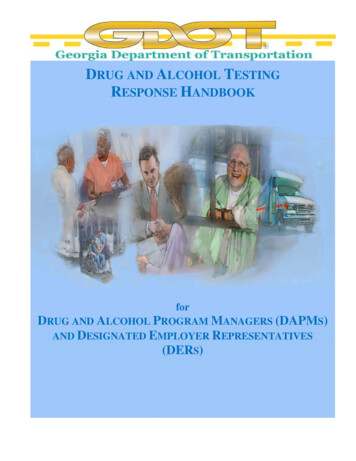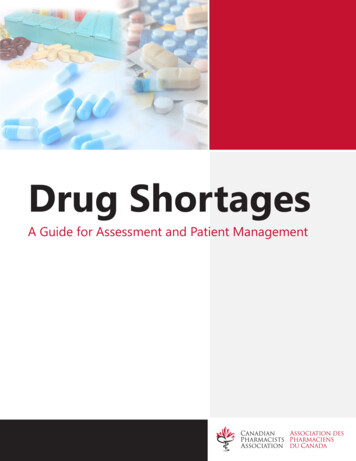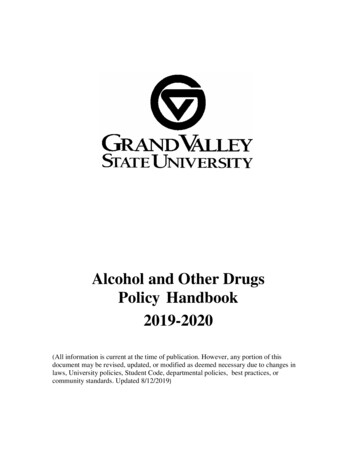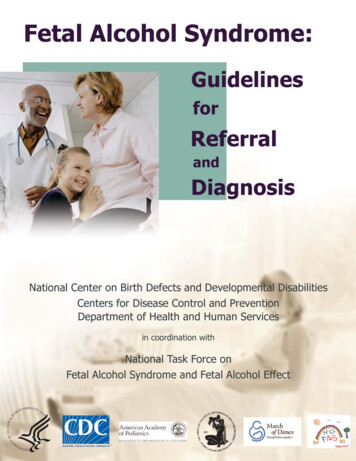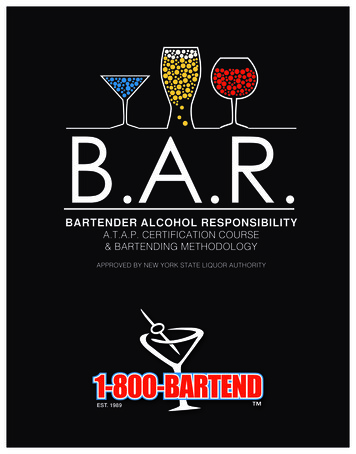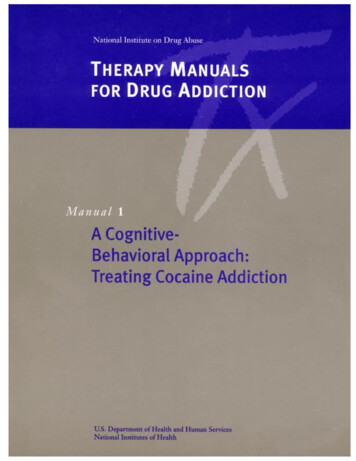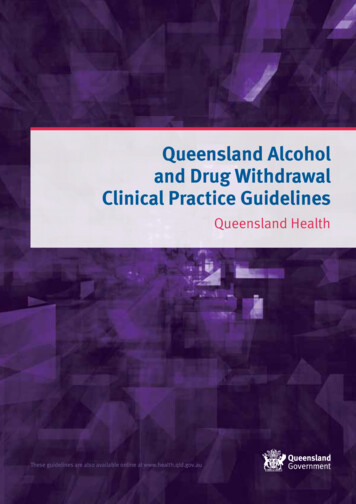
Transcription
Queensland Alcoholand Drug WithdrawalClinical Practice GuidelinesQueensland HealthThese guidelines are also available online at www.health.qld.gov.au
Mental Health, Alcohol and Other Drugs DirectorateLevel 2, 15 Butterfield StreetHerston Qld 4006PO Box 2368Fortitude Valley BC 4006Main phone: 07 3328 9506Main fax: 07 3328 9126These guidelines have been adapted from the Drug and Alcohol Withdrawal Clinical PracticeGuidelines – NSW with the kind permission of the Mental Health and Drug and Alcohol Office, NewSouth Wales Ministry of Health.The guidelines have been developed to provide clinicians with a comprehensive manual that coversall aspects of withdrawal management.The guidelines are not intended to replace clinical judgment in individual cases, but they will assist inmanaging patients safely and effectively.As with all medical practice, clinicians are encouraged to document decisions made with regard towithdrawal management clearly in the patient’s notes.This work is copyright. It may be reproduced in whole or in part for study or training purposes subjectto the inclusion of an acknowledgement of the source. It may not be reproduced for commercialusage or sale. Reproduction for purposes other than those indicated requires written permission fromQueensland Health. Queensland HealthFor further copies of this document, please contact:Mental Health, Alcohol and Other Drugs DirectorateLevel 2, 15 Butterfield StreetHerston Qld 4006PO Box 2368Fortitude Valley BC 4006Main phone: 07 3328 9506Main fax: 07 3328 9126Further copies of this document can be downloaded from the Queensland Health website:www.health.qld.gov.auAugust 2012ISBN: 978-1-921707-83-4
Queensland Alcohol and Drug Withdrawal Clinical Practice GuidelinesContents0. Headline1. Introduction. 41.1 Background. 41.2 Dependence, toleranceand withdrawal. 51.2.1 ICD-10 definitions.51.2.2 DSM-IV definitions.52. General principles of withdrawalmanagement. 62.1 Rationale and underlying principles for withdrawalmanagement . 72.2 Presentation for withdrawal management. 72.2.1 Elective presentations.72.2.2 Crisis presentations .82.2.3 Unplanned withdrawal.82.2.4 Information about withdrawal service.82.3 Assessment for withdrawal management. 82.3.1 Primary aims of assessment.82.3.2 Key elements in assessment.82.3.3 Full consumption history.92.3.4 Brief consumption history.102.3.5 Street names and prices of drugs.112.3.6 Consumption calculations.122.3.7 Identifying risks associated withpolydrug use.162.3.8 Selective withdrawal.162.3.9 Identifying history of withdrawal.162.3.10 Assessing current withdrawal status.172.3.11 Physical examination for withdrawalmanagement.172.3.12 Mental health assessment.182.3.13 Screening for domestic violence.182.3.14 Psychosocial assessment.182.3.15 Child protection.192.3.16 Formulating the management plan.192.6 Treating withdrawal. 232.6.1 Monitoring.232.6.2 Pharmacological treatment.232.6.3 Routine supportive care.232.6.4 Managing difficult behaviour.242.6.5 Driving.252.7 HIV, hepatitis B and hepatitis C screening. 252.8 Continuing care. 262.8.1 Discharge planning.263. Alcohol. 283.1 Use and effects of alcohol. 293.2 Assessment issues specificto alcohol-dependent patients. 293.2.1 Unplanned withdrawal.303.3 Alcohol withdrawal. 303.3.1 Onset and duration .303.3.2 Signs and symptoms .313.4 Monitoring. 313.4.1 Routine observations during withdrawal.313.5 Treatment. 323.5.1 Supportive care.323.5.2 Medication.323.5.3 Preventing dehydration.323.5.4 Routine prevention of Wernicke’sencephalopathy.333.5.5 Ambulatory withdrawal treatment.333.6 Special issues. 343.6.1 Seizures.343.6.2 Delirium tremens.343.6.3 Management of withdrawal withintercurrent illness.353.6.4 Pregnancy.363.7 Continuing care. 362.4 Treatment-matching for withdrawal management. 202.4.1 Special groups .202.5 Treatment agreements. 22Queensland Health1
Queensland Alcohol and Drug Withdrawal Clinical Practice GuidelinesContents4. Benzodiazepines. 374.1 Use and effects of benzodiazepines. 384.2 Assessment issues specificto benzodiazepine-dependent patients. 394.2.1 Patterns of use.394.3 Withdrawal. 404.3.1 Incidence of benzodiazepine withdrawal.404.3.2 Onset and duration of benzodiazepinewithdrawal.404.3.3 Signs and symptoms of benzodiazepinewithdrawal.404.4 Monitoring. 414.5 Treatment. 414.5.1 Treatment setting for benzodiazepinewithdrawal.424.5.2 Withdrawal management.424.5.3 Unplanned withdrawal.434.5.4 Managing benzodiazepine withdrawal inpolydrug-dependent patients.434.5.5 Pregnancy.444.6 Continuing care. 445. Opioids. 455.1 Use and effects of opioid drugs . 465.2 Assessment issues specificto opioid-dependent patients. 475.2.1 Assessing opioid dependence.475.2.2 Unplanned withdrawal.475.3 Withdrawal. 485.3.1 Onset and duration of withdrawal.485.3.2 Signs and symptoms of opioid withdrawal.485.3.3 Monitoring.485.3.4 Withdrawal scales.485.4 Treatment. 495.4.1 The regulatory context of addictiontreatment.495.4.3 Key elements of opioid withdrawaltreatment.495.4.4 Buprenorphine.502Queensland Health5.5 Special issues. 525.5.1 Pregnancy and breastfeeding.525.6 Continuing care. 525.6.1 Transfer to naltrexone.535.6.2 Post-withdrawal management.536. Cannabis. 546.1 Use and effects of cannabis. 556.2 Assessment issues specific to cannabis-dependentpatients. 556.3 Withdrawal. 556.3.1 Onset and duration ofcannabis withdrawal.556.3.2 Symptoms of cannabis withdrawal.566.3.3 Factors contributing to withdrawalseverity.566.4 Treatment. 576.4.1 Indications for inpatientcannabis withdrawal.576.4.2 Pharmacotherapies.586.4.3 Symptomatic relief bysymptom cluster.586.4.4 Psychosocial management, includingdose tapering.586.5 Special issues. 596.5.1 Premorbidly aggressive andprison populations.596.5.2 Pregnancy.606.5.3 Pain.606.5.4 Young people.606.5.5 Comorbid psychiatric conditions.606.6 Continuing care . 61
Queensland Alcohol and Drug Withdrawal Clinical Practice GuidelinesContents7. Psychostimulants (amphetamines,cocaine and ecstasy). 627.1 Use and effects of psychostimulants. 637.2 Assessment issues specific for stimulant users. 647.2.1 Regular monitoring and repeatedassessment over time.647.2.2 Assessment of potential complicationsof psychostimulant use.647.2.3 Unplanned withdrawal.657.3 Withdrawal. 667.3.1 Onset and duration.667.3.2 Factors affecting severity of withdrawal.667.4 Monitoring. 677.5 Treatment. 677.5.1 Treatment planning.677.5.2 Treatment settings.677.5.3 Supportive care.677.5.4 Pharmacotherapies.677.5.5 Addressing complicationsduring withdrawal.687.6 Continuing care. 68References and suggestedreadings list. 76Selected web sites andinformation lines. 80Appendices. 88Appendix A. 89Appendix B. 90Appendix C. 92Appendix D. 97Appendix E. 98Appendix F. 99Appendix G. 100Appendix H. 102Appendix I. 114Appendix J. 122Appendix K. 1238. Nicotine. 698.1 Use and effects of nicotine. 708.2 Assessment issues specific for nicotine-dependentpatients. 708.3 Withdrawal. 708.3.1 Onset and duration of nicotinewithdrawal.708.3.2 Factors contributing to withdrawalseverity.718.4 Treatment. 718.4.1 Indication for inpatient nicotinewithdrawal.718.4.2 Pharmacotherapies.728.5 Special issues. 748.5.1 Pregnancy.748.5.2 Mental Illness.748.5.3 Medications.748.6 Continuing care . 75Queensland Health3
Queensland Alcohol and Drug Withdrawal Clinical Practice Guidelines1. Introduction1.Introduction1.1BackgroundThe Queensland Drug and Alcohol WithdrawalClinical Practice Guidelines provides the mostup-to-date knowledge and current level of bestpractice for treating withdrawal from alcoholand other drugs, such as benzodiazepines,heroin and other opioids, cannabis, andpsychostimulants. The specific problems ofpolydrug use are also addressed.Specialist withdrawal services, hospitals,psychiatric units, correctional settings andcommunity health services in the Queenslandpublic health system (including non-governmentagencies funded by Queensland Health) arerecommended to adopt these guidelines.These clinical practice guidelines updateand supersede the Clinical Protocols forDetoxification in Hospitals and DetoxificationFacilities and Clinical Protocols for Detoxificationin General Practice and Community Settings2002.Drug withdrawal may occur in a predictableway in a withdrawal unit or it may occurunexpectedly in an acute care setting followingan unplanned admission. The aim of thisdocument is to assist three broad groupsof clinicians to manage drug and alcoholdependent people who are experiencingwithdrawal:1. Specialist withdrawal services thattreat individuals on an outpatientand inpatient basis for alcohol anddrug withdrawal4Queensland Health2. Hospitals, nursing homes, and other acutefacilities that admit patients for primarymedical problems and are then faced with anunexpected withdrawal syndrome3. Primary care clinicians – such as generalpractitioners, non-government agencies,offender health services and community andwelfare services – that deal with people whomay experience alcohol and drug problemsincluding withdrawal.This document includes developments sincethe previous Queensland detoxification clinicalprotocols were published in 2002. The mainchanges and additions are: The term ‘detoxification’ is no longerscientifically acceptable and the term‘withdrawal management’ has been adopted. Buprenorphine has been approved inAustralia for the treatment of opioid (heroin)withdrawal and maintenance. This is nowincluded. Cannabis dependence and cannabiswithdrawal have been documented inrecent literature and are discussed in theseguidelines.Patient safety is the key concept in themanagement of withdrawal. These guidelinesare designed to allow clinicians to offersafe withdrawal management to dependentindividuals.
Queensland Alcohol and Drug Withdrawal Clinical Practice Guidelines1. Introduction1.2Dependence, toleranceand withdrawalWithdrawal occurs in alcohol and drugdependent people who stop or considerablyreduce their drug use. The diagnosis ofdependence is generally required in orderto understand and manage drug withdrawal.1.2.1 ICD-10 definitionsThe International Classification of Diseases,10th Revision (ICD-10) contains the followingdefinitions:Dependence syndrome1.2.2 DSM-IV definitionsThe Diagnostic and Statistical Manual of MentalDisorders, Fourth Edition (DSM-IV) contains thefollowing definitions:Substance dependenceSubstance dependence is a maladaptive patternof substance use, leading to clinically significantimpairment or distress, as manifested by 3 ormore of the following occurring at any time in thesame 12-month period: tolerance, as defined by either of thefollowing:– a need for markedly increased amounts ofthe substance to achieve intoxication or thedesired effectThis syndrome is a cluster of behavioural,cognitive and physiological phenomena thatdevelop after repeated substance use and thattypically include a strong desire to take thedrug, difficulties in controlling its use, persistingin its use despite harmful consequences, ahigher priority given to drug use than to otheractivities and obligations, increased toleranceand, sometimes, a physical withdrawal state. withdrawal, as manifested by either ofthe following:The dependence syndrome may be present fora specific psychoactive substance (e.g. tobacco,alcohol or diazepam), for a class of substances(e.g. opioid drugs), or for a wider range ofpharmacologically different psychoactivesubstances. the substance is often taken in largeramounts or over a longer period than wasintendedWithdrawal stateA withdrawal state is a group of symptomsof variable clustering and severity occurringon absolute or relative withdrawal of apsychoactive substance after persistent useof that substance. The onset and courseof the withdrawal state are time-limitedand are related to the type of psychoactivesubstance and dose being used immediatelybefore cessation or reduction of use.– markedly diminished effect with continueduse of the same amount of the substance– the characteristic withdrawal syndromefor the substance– the same (or a closely related) substanceis taken to relieve or avoid withdrawalsymptoms there is a persistent desire or unsuccessfulefforts to cut down or control substance use a great deal of time is spent in activitiesnecessary to obtain the substance, use thesubstance or recover from its effects important social, occupational or recreationalactivities are given up or reduced because ofsubstance use the substance use is continued despiteknowledge of having a persistent or recurrentphysical or psychological problem that islikely to have been caused or exacerbated bythe substance.Queensland Health5
Queensland Alcohol and Drug Withdrawal Clinical Practice Guidelines2. G eneral principlesof withdrawal management2.General principles of withdrawal managementKey points Withdrawal management provides an opportunity for engagement, planning and coordination ofpost-withdrawal care. Patients may present for elective withdrawal, present when already in withdrawal (crisispresentation), or commence withdrawal incidentally when in treatment for another condition. A comprehensive assessment is the first step in managing the withdrawal process. It will definethe risks that will confront the patient by identifying alcohol, drug use and health issues for thepatient and it will also identify specific needs that may interfere with successfully completingwithdrawal. For each drug (prescribed or not) an accurate consumption history should record: the quantity,frequency, duration and pattern of use; time and amount of last use; route of administration;recent pattern leading up to this presentation; and average daily consumption. For prescribedmedications, also record the prescribed dose and prescribing doctor. Try to match the patient with the withdrawal treatment approach that maximises patient safetyand provides the most effective and most resource-efficient options for their management. If possible, formalise a treatment agreement with the patient. The agreement may be verbal orwritten. It should not be used against the patient in a punitive manner. Frequent observations of the patient are the mainstay of management. Assessment of clinicalfeatures, explanation, reassurance and repeated encouragement are provided at these times. Medication is used in withdrawal to provide symptomatic relief, to treat complications andcoexisting conditions, and to reduce the intensity of withdrawal. The aim of supportive care is to minimise environmental stimuli that may exacerbate withdrawalsymptoms and to enhance the patient’s ability to complete withdrawal successfully. Develop strategies to help the patient cope with the period after withdrawal, particularly if thepatient required withdrawal management in hospital. Strategies for discharge should encourageharm reduction and referral to appropriate agencies. The withdrawal state from some drugs may be complicated by seizures that may belife-threatening.6Queensland Health
Queensland Alcohol and Drug Withdrawal Clinical Practice Guidelines2. General principlesof withdrawal management2.1Rationale and underlyingprinciples for withdrawalmanagementWhen a person is dependent on a drug,withdrawal of the drug carries risks of physicalharm, psychological trauma and (rarely) death.The aim of withdrawal management is tominimise the risks associated with withdrawal.The rationale of withdrawal management isto provide the appropriate level of supportso that withdrawal can be completed safely,which then allows the individual to determinehis or her optimal ongoing managementstrategy. An understanding of the pharmacologyand physiology of withdrawal allows theuse of appropriate medications to modifythe withdrawal process, making it safer andmore tolerable.Underlying principles: While withdrawal management may be anopportunity to initiate lasting abstinence, theprimary goal is patient safety, not long-termabstinence. Withdrawal management services shouldnot be withheld from people because ofdoubts about their commitment to long-termabstinence. Supportive care and patient choice are crucialto success. Supportive care should includeattention to the patient’s environment,the transfer of information, reassurance,attention to anxiety, and assistance with thedevelopment of coping skills. The syndrome of withdrawal should bemonitored clinically and appropriate careshould be provided. This can range fromcounselling and support to the use of specificmedications to ameliorate symptoms ofwithdrawal. Planning and coordinating post-withdrawalcare is an integral part of treatment.2.2Presentation forwithdrawal managementPatients present for withdrawal managementwith a mixture of attitudes and emotions. Somepresent in crisis. They may be suspicious ofpeople in positions of authority as a result ofprevious experiences in a variety of settings,including the healthcare system. The initialassessment is an important opportunityto begin building an effective therapeuticrelationship with the patient. Be non-judgmental, empathetic andrespectful. Listen and clearly elucidate the patient’s needs. Encourage the patient to actively participatein treatment decisions from the outset. Communicate clearly, and allow time for thepatient to understand what assistance isbeing offered and the reasons for it.It is common for drug-dependent people to present in astate of intoxication (which can complicate assessmentand management of withdrawal) or overdose, which canbe life-threatening. Both intoxication and overdose mayrequire acute medical care.See Appendix B for guidelines on assessmentand management of intoxication and overdose.2.2.1 Elective presentationsThe objective in managing patients seekingelective withdrawal management is to balancethe need for safety with patient choice anddesirable outcomes.In order of priority, this requires: identifying withdrawal risks assessing psychosocial factors matching safety requirements andpsychosocial factors to the treatment setting.Queensland Health7
Queensland Alcohol and Drug Withdrawal Clinical Practice Guidelines2. General principlesof withdrawal management2.2.2 Crisis presentations2.2.4 Information about withdrawal service(presenting in withdrawal)Alcohol Drug Information Service (ADIS)Crisis presentations generally involve peoplewho are already in withdrawal. The patient maypresent to a variety of settings (e.g. emergencydepartment, drug and alcohol unit, psychiatricservice, correctional service, emergencyaccommodation centre, general practitioner or ahospital ward).ADIS is a 24-hour, 7-day phone service forpeople seeking information or assistance withdrug or alcohol issues. The telephone linealso provides assessment, referral and briefcounselling.The critical issues are: prompt identification of the withdrawalAlcohol Drug Information Service (ADIS)Phone: 1800 177 83324-hour, 7-day phone service minimising the risk of complications managing withdrawal symptoms stabilising medical and psychiatricconditions.2.2.3 Unplanned withdrawalSome people in the care of a clinician forreasons other than withdrawal managementmay begin to undergo withdrawal. These peoplemay be receiving acute care in a hospital orbeing assisted with psychiatric, medical orsurgical problems in other settings.Assessment for unplanned withdrawal is similarto that for crisis presentations.Early detection of withdrawal and preventingthe risks associated with withdrawal are the keyconsiderations.The key to effective management iscoordinating withdrawal and other clinical care.Withdrawal may increase the expected hospitallength of stay of the patient or require theirtransfer to a more suitable setting.2.3Assessment forwithdrawal management2.3.1 Primary aims of assessmentAssessment is the first step in managing drugand alcohol withdrawal. The primary aims are to: predict the risks that will confront the patientbecause of withdrawal identify the specific needs of the patientto enhance the likelihood of completingwithdrawal (i.e. to match treatment to patientneeds) begin building a therapeutic relationship withthe patient.Clinicians should: take care to ensure that personal values andstereotypes do not interfere with effectiveassessment of the patient explain the purpose of each element of theassessment process to the patient seek the active involvement of the patient inplanning treatment.2.3.2 Key elements in assessmentComponents of a comprehensive assessment are: full drug consumption history identifying risks associated with polydrug use8Queensland Health
Queensland Alcohol and Drug Withdrawal Clinical Practice Guidelines2. General principlesof withdrawal management identifying history of withdrawal and anyassociated complications Ascertain how much was consumedat that time. medical and psychiatric history Enquire back through that day: ‘What aboutduring the day?’ physical examination mental state examination appropriate laboratory investigations psychosocial assessment to identifyexpectations, supports, barriers andpreferences that may influence withdrawalmanagement formulating a management plan.Psychosocial assessment can be deferred if thepatient is unwell, but it will help to plan futurecare and determine treatment options.Note: In some circumstances, the advice orassistance of a drug and alcohol specialist –or other specialist – may be required.2.3.3 Full consumption historyObtain a description of the patient’sconsumption over a typical week or month,as there is a degree of correlation betweenthe quantity consumed and the severity ofwithdrawal. Link consumption to activities: ‘What wereyou doing during the day?’ Then, for example:‘How much did you drink or use when youwent to your friend’s house?’ Examine consumption through each day forthe past week. Then ask if that was a typical week’s pattern.If not, ask specifically how it differed (i.e. howmuch more or less of each drug than usual). Recording a complete consumption history isnot always practical because of the context ofthe presentation, including the physical andmental state of the person in withdrawal. A common drug combination that should benoted is alcohol and benzodiazepines. Thesedrugs produce cross-tolerance and regularuse of both can make withdrawal moresevere and protracted.Recording consumption historyAn accurate consumption history should recordfor each drug (whether prescribed or not):First, obtain a general history of alcohol anddrug use, then attempt to identify daily patternsof alcohol and drug consumption from aretrospective consumption history. quantity, frequency, duration of use andpattern of useMost people, with or without alcohol anddrug problems, are likely to underestimate orestimate inaccurately how much they use ifasked the question: ‘On average, how much doyou use a day or a week?’ recent pattern leading up to this presentationTaking a retrospective consumption history time and amount of last use route of administration average daily consumption periods and longest period of abstinence.For prescribed medications, also record thepre
of clinicians to manage drug and alcohol dependent people who are experiencing withdrawal: 1. Specialist withdrawal services that treat individuals on an outpatient and inpatient basis for alcohol and drug withdrawal 2. Hospitals, nursing homes, and other acute facilities that admit patient

